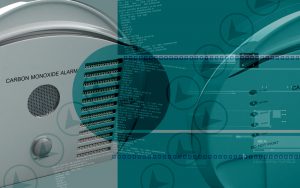One of the most important home owner tips is keeping your family safe from carbon monoxide. Known as the silent killer, carbon monoxide is an invisible, odorless, colorless gas created when fuels –such as natural gas, propane or oil – burn incompletely. The Center for Disease Control and Prevention reports that between 2000 and 2009, more than 68,000 people were treated for carbon monoxide poisoning in the United States, and more than 200 deaths occurred due to exposure.  Symptoms of Carbon Monoxide Poisoning
One reason home owner tips must include information about preventing carbon monoxide poisoning is that the symptoms are very similar to common illnesses; mild exposure can cause slight headaches, nausea, vomiting and fatigue. As the levels of carbon monoxide increase, symptoms worsen, sometimes rapidly. The worsening symptoms include severe, throbbing headache, drowsiness, confusion and rapid heart rate. Eventually, the exposed person becomes unconscious, suffers convulsions, cardiorespiratory failure and death.
Carbon Monoxide and Humans
Carbon monoxide replaces oxygen in the bloodstream, eventually causing suffocation. People are exposed to carbon monoxide when they leave their car running, burn charcoal, alcohol or gasoline in an enclosed area, or smoke tobacco products. In addition, carbon monoxide can leak into your home when a hot water heater, furnace, space heater, fireplace, or stove is improperly installed or vented. Because a faulty HVAC system can leak carbon monoxide into your home, scheduling annual inspections of your system, along with the use of a carbon monoxide detector, are crucial home owner tips.
Carbon Monoxide Detectors
Carbon monoxide levels are measured in parts per million (ppm), with poisoning symptoms of headache and nausea beginning with measurements of 400 ppm. At that level, death can occur within three hours, while at 1600 ppm, death can occur with one hour. Carbon monoxide detectors are required to sound an alarm between 60 and 240 minutes when levels in an area reach 70 ppm. When levels reach 150 ppm, the alarms must sound between 10 and 15 minutes and at 400 ppm, between 4 and 15 minutes. This alerts those in the area to evacuate before the levels become dangerous. For those that use fuel for heating or cooking in their home, installing a carbon monoxide detector is an important home owner tip.
For more home owner tips, or more information about carbon monoxide poisoning prevention through their Comfort Maintenance Plan, visit Spencer Air Conditioning and Heating online. Be sure to connect with us on Facebook, Twitter and LinkedIn!
Symptoms of Carbon Monoxide Poisoning
One reason home owner tips must include information about preventing carbon monoxide poisoning is that the symptoms are very similar to common illnesses; mild exposure can cause slight headaches, nausea, vomiting and fatigue. As the levels of carbon monoxide increase, symptoms worsen, sometimes rapidly. The worsening symptoms include severe, throbbing headache, drowsiness, confusion and rapid heart rate. Eventually, the exposed person becomes unconscious, suffers convulsions, cardiorespiratory failure and death.
Carbon Monoxide and Humans
Carbon monoxide replaces oxygen in the bloodstream, eventually causing suffocation. People are exposed to carbon monoxide when they leave their car running, burn charcoal, alcohol or gasoline in an enclosed area, or smoke tobacco products. In addition, carbon monoxide can leak into your home when a hot water heater, furnace, space heater, fireplace, or stove is improperly installed or vented. Because a faulty HVAC system can leak carbon monoxide into your home, scheduling annual inspections of your system, along with the use of a carbon monoxide detector, are crucial home owner tips.
Carbon Monoxide Detectors
Carbon monoxide levels are measured in parts per million (ppm), with poisoning symptoms of headache and nausea beginning with measurements of 400 ppm. At that level, death can occur within three hours, while at 1600 ppm, death can occur with one hour. Carbon monoxide detectors are required to sound an alarm between 60 and 240 minutes when levels in an area reach 70 ppm. When levels reach 150 ppm, the alarms must sound between 10 and 15 minutes and at 400 ppm, between 4 and 15 minutes. This alerts those in the area to evacuate before the levels become dangerous. For those that use fuel for heating or cooking in their home, installing a carbon monoxide detector is an important home owner tip.
For more home owner tips, or more information about carbon monoxide poisoning prevention through their Comfort Maintenance Plan, visit Spencer Air Conditioning and Heating online. Be sure to connect with us on Facebook, Twitter and LinkedIn!
 Symptoms of Carbon Monoxide Poisoning
One reason home owner tips must include information about preventing carbon monoxide poisoning is that the symptoms are very similar to common illnesses; mild exposure can cause slight headaches, nausea, vomiting and fatigue. As the levels of carbon monoxide increase, symptoms worsen, sometimes rapidly. The worsening symptoms include severe, throbbing headache, drowsiness, confusion and rapid heart rate. Eventually, the exposed person becomes unconscious, suffers convulsions, cardiorespiratory failure and death.
Carbon Monoxide and Humans
Carbon monoxide replaces oxygen in the bloodstream, eventually causing suffocation. People are exposed to carbon monoxide when they leave their car running, burn charcoal, alcohol or gasoline in an enclosed area, or smoke tobacco products. In addition, carbon monoxide can leak into your home when a hot water heater, furnace, space heater, fireplace, or stove is improperly installed or vented. Because a faulty HVAC system can leak carbon monoxide into your home, scheduling annual inspections of your system, along with the use of a carbon monoxide detector, are crucial home owner tips.
Carbon Monoxide Detectors
Carbon monoxide levels are measured in parts per million (ppm), with poisoning symptoms of headache and nausea beginning with measurements of 400 ppm. At that level, death can occur within three hours, while at 1600 ppm, death can occur with one hour. Carbon monoxide detectors are required to sound an alarm between 60 and 240 minutes when levels in an area reach 70 ppm. When levels reach 150 ppm, the alarms must sound between 10 and 15 minutes and at 400 ppm, between 4 and 15 minutes. This alerts those in the area to evacuate before the levels become dangerous. For those that use fuel for heating or cooking in their home, installing a carbon monoxide detector is an important home owner tip.
For more home owner tips, or more information about carbon monoxide poisoning prevention through their Comfort Maintenance Plan, visit Spencer Air Conditioning and Heating online. Be sure to connect with us on Facebook, Twitter and LinkedIn!
Symptoms of Carbon Monoxide Poisoning
One reason home owner tips must include information about preventing carbon monoxide poisoning is that the symptoms are very similar to common illnesses; mild exposure can cause slight headaches, nausea, vomiting and fatigue. As the levels of carbon monoxide increase, symptoms worsen, sometimes rapidly. The worsening symptoms include severe, throbbing headache, drowsiness, confusion and rapid heart rate. Eventually, the exposed person becomes unconscious, suffers convulsions, cardiorespiratory failure and death.
Carbon Monoxide and Humans
Carbon monoxide replaces oxygen in the bloodstream, eventually causing suffocation. People are exposed to carbon monoxide when they leave their car running, burn charcoal, alcohol or gasoline in an enclosed area, or smoke tobacco products. In addition, carbon monoxide can leak into your home when a hot water heater, furnace, space heater, fireplace, or stove is improperly installed or vented. Because a faulty HVAC system can leak carbon monoxide into your home, scheduling annual inspections of your system, along with the use of a carbon monoxide detector, are crucial home owner tips.
Carbon Monoxide Detectors
Carbon monoxide levels are measured in parts per million (ppm), with poisoning symptoms of headache and nausea beginning with measurements of 400 ppm. At that level, death can occur within three hours, while at 1600 ppm, death can occur with one hour. Carbon monoxide detectors are required to sound an alarm between 60 and 240 minutes when levels in an area reach 70 ppm. When levels reach 150 ppm, the alarms must sound between 10 and 15 minutes and at 400 ppm, between 4 and 15 minutes. This alerts those in the area to evacuate before the levels become dangerous. For those that use fuel for heating or cooking in their home, installing a carbon monoxide detector is an important home owner tip.
For more home owner tips, or more information about carbon monoxide poisoning prevention through their Comfort Maintenance Plan, visit Spencer Air Conditioning and Heating online. Be sure to connect with us on Facebook, Twitter and LinkedIn! 



